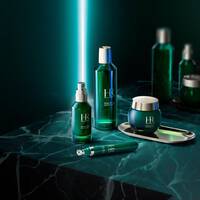What Exactly Is the Exposome and how does it affect my skin?
The term exposome refers to all the environmental and lifestyle factors that our skin is exposed to over time. It encompasses everything from UV rays, pollution, air temperature and climate change to diet, stress, and tobacco amongst other.
From all the environmental factors, UV-radiation has the greatest impact. Some UV rays (long UVAs) can penetrate up to the deepest skin layers. On the short term they are responsible for skin dryness and dullness but their effect has also been studied on the long term where they have proven to accelerate skin aging (wrinkling, sagging, spots, unevenness).
The impact of air pollution is the second most studied and its deleterious effects are now proven, mainly on skin pigmentation: An increase in 10 mg/m3 NO2 is correlated with 25% more pigment spots on the cheeks in German women, and 24% in Chinese women [2].
Clinical studies on Twins have associated smoking with increased wrinkles, tissue laxity and pigmentary changes. It is estimated that 10 years of smoking corresponds to a difference of appearance of more than 2 years [2].
The different stressors can interact and amplify one another, leading to increased inflammation, oxidation, and breakdown of the skin’s natural defense mechanisms. As an example, ex vivo tests have shown that oxidation of sebum is increased by 3.5 times when UVA rays are combined with pollution (vs UVA alone), showing the deleterious synergistic effect of those stressors. The resulting oxidation of this mix of UVA rays and pollutants contributes to skin aging and the occurrence of dark spots [3].
What is ozone, the latest air pollutant?
Ozone (O₃) is a molecule made up of three oxygen atoms. In the stratosphere, ozone forms a protective layer that shields the Earth from harmful UV rays. It is therefore considered as “good” ozone. But at ground level, ozone is a toxic pollutant and an ever-growing threat to skin health, therefore often referred to as “bad” ozone [4]. Ground-level ozone forms through chemical reactions due to industry (vehicle emissions, industrial pollutants) but also in nature where it is used as a communication molecule by certain plants. Sunlight being a trigger of the reaction, ozone is therefore especially prevalent on hot summer days. This "bad" ozone is one of the few pollutants still on the rise in industrialized nations and is increasingly recognized as a catalyst for skin aging [5]. The intensity of ozone is greater during the summer months, particularly July and August, when ozone levels peak due to higher temperatures and greater amounts of solar radiation [6].
What are the effects of ozone on skin?
The Helena Rubinstein laboratories have designed an original protocol using the “Pollubox” to decypher the role of ozone in skin. This device allows to expose skin samples to a series of stressors, each combined with the preceding stressors. First, the samples were exposed to pollutants including benzene and heavy metals, followed by the addition of UVA radiation, then blue light for a period of two hours and, finally, for some samples only, the addition of ozone for a period of 30 minutes. The samples exposed to ozone as a final step showed an increase of 1.6 times in the oxidation of skin lipids (measure of 4-HNE in skin) and an increase of 2.5 times in inflammation (measure of IL-1α in skin). Oxidation and inflammation are known to contribute to premature skin aging by increasing irritation, redness, flakiness, and fine lines.
In conclusion, results clearly show that ozone aggravates skin ageing. More importantly, when combined to solar radiation, it acts an amplifier intensifying damage caused by other stressors. It sets off a cascade of biological reactions, disrupting skin homeostasis and accelerating skin damages and signs of aging from superficial to deeper skin layers.
Ozone, the New Beauty Enemy: A Growing Threat in an Era of Global Warming
Due to global warming, ozone levels are expected to rise even further. Urban areas are experiencing increasing ozone pollution. As one of the most concerning air pollutants of our time, ozone constitutes a clear and present beauty threat that can no longer be ignored. It interacts with other elements of the exposome to create a domino effect of skin damage.
[1] Farage MA, Miller KW, Elsner P, Maibach HI. Intrinsic and extrinsic factors in skin ageing: a review. Int J Cosmet Sci. 2008;30(2):87–95
[2] Krutmann J, Bouloc A, Sore G, Bernard BA, Passeron T. The skin aging exposome. J Dermatol Sci. 2017 Mar;85(3):152-161.
[3] Lebfevre MA, et al. International Journal of Cosmetic Science, June 2016: 38 (3): 217
[4] Donzelli, G et al. Tropospheric Ozone: A Critical Review of the Literature on Emissions, Exposure, and Health Effects. Atmosphere 2024, 15, 779. https:// doi.org/10.3390/atmos15070779
[5] L. Marrot - Pollution and Sun Exposure: A Deleterious Synergy. Mechanisms and Opportunities for Skin Protection. Current Medicinal Chemistry, 2018, 25, 40, 5469-5486
[6] Y. Yang et al. Meteorological characteristics of extreme ozone pollution events in China and their future predictions. Atmospheric Chemistry and Physics, 2024, 24, 1177-1191












